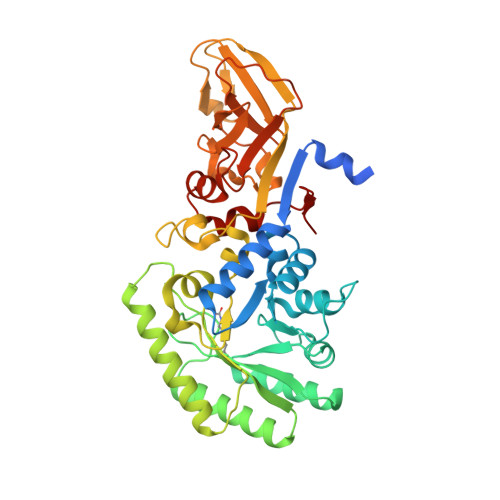Structural and functional characterization of the alanine racemase from Streptomyces coelicolor A3(2).
Tassoni, R., van der Aart, L.T., Ubbink, M., van Wezel, G.P., Pannu, N.S.(2017) Biochem Biophys Res Commun 483: 122-128
- PubMed: 28042035
- DOI: https://doi.org/10.1016/j.bbrc.2016.12.183
- Primary Citation of Related Structures:
5FAC, 5FAG, 5FAJ - PubMed Abstract:
The conversion of l-alanine (L-Ala) into d-alanine (D-Ala) in bacteria is performed by pyridoxal phosphate-dependent enzymes called alanine racemases. D-Ala is an essential component of the bacterial peptidoglycan and hence required for survival. The Gram-positive bacterium Streptomyces coelicolor has at least one alanine racemase encoded by alr. Here, we describe an alr deletion mutant of S.?coelicolor which depends on D-Ala for growth and shows increased sensitivity to the antibiotic d-cycloserine (DCS). The crystal structure of the alanine racemase (Alr) was solved with and without the inhibitors DCS or propionate, at 1.64?? and 1.51?? resolution, respectively. The crystal structures revealed that Alr is a homodimer with residues from both monomers contributing to the active site. The dimeric state of the enzyme in solution was confirmed by gel filtration chromatography, with and without L-Ala or d-cycloserine. The activity of the enzyme was 66?¡À?3 U?mg -1 for the racemization of L- to D-Ala, and 104?¡À?7 U?mg -1 for the opposite direction. Comparison of Alr from S.?coelicolor with orthologous enzymes from other bacteria, including the closely related d-cycloserine-resistant Alr from S.?lavendulae, strongly suggests that structural features such as the hinge angle or the surface area between the monomers do not contribute to d-cycloserine resistance, and the molecular basis for resistance therefore remains elusive.
Organizational Affiliation:
Leiden Institute of Chemistry, Leiden University, Gorlaeus Laboratories, Einsteinweg 55, 2333 CC Leiden, The Netherlands.

















